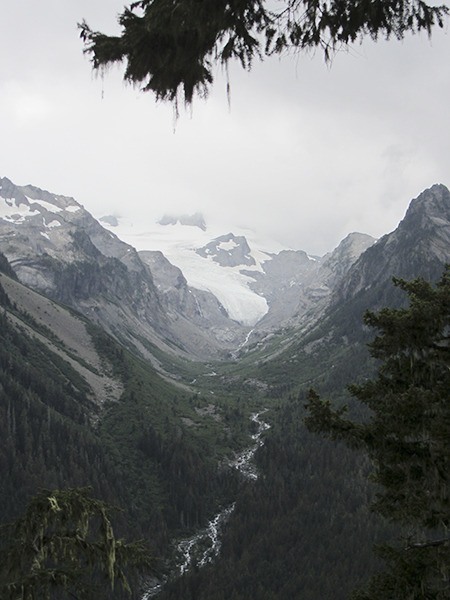Higher-than-average temperatures are rapidly melting the Olympic Mountain snowpack.
While the relatively warm weather doesn’t necessarily indicate that the Olympic Peninsula is headed toward drought, local and regional hydrologists say they are keeping an eye on area forecasts and water levels.
“At first, warmer air temperatures in April did not affect snow water equivalencies; however, continued warmer temperatures into May have reduced the snowpack quickly,” Don Watt, Washington State Department of Ecology hydrologist, said in the agency’s “Eyes Over Puget Sound” May 2 report.
Throughout the past month average temperatures were 6-7 degrees above normal along the Cascade Crest and on the high peaks in the Olympics, Watt reported.
Despite near, at or above normal snow accumulation statewide at the beginning of April, by early May mountain snowpack had dwindled to between 37 percent and 80 percent of seasonal normal.
“Typically this time of year we’re tending to lose the snowpack anyways, but it’s happening at a much more rapid rate this year and started earlier than normal,” said Kevin Berghoff, National Weather Service’s Northwest River Forecast Center senior hydrologist.
Compared with all other Washington basins, with 80 percent “snow water equivalent” (amount of water contained within the snowpack) basin-wide of its 30-year median, Olympic Mountain snowpack remains the closet to normal. However, based on data from fully automated weather stations (SNOTEL) operated by the Natural Resources Conservation Service throughout multiple states, including four sites in the Olympics, the Dungeness SNOTEL site at 4,010-feet elevation has no snow.
The site “melted out three weeks sooner than on average,” Ann Soule, City of Sequim water resource specialist, reported in her water-related “April Highlights.”
“Being two to three weeks ahead of schedule isn’t anything to panic about, but we’re watching the forecast,” she said. “If state and federal agencies are predicting warmer than normal temperatures in the early summer, then that’s when there might be a cause for concern.”
“If we see all those snowfields that are still visible disappear quickly, then we might be in trouble again in August,” she said.
The early snowmelt is consistent with official observations and predictions.
Most SNOTEL stations peaked at or close to normal snowpack conditions a little earlier than anticipated, but also started to “rapidly” melt off by early April, Berghoff said. “Given the current trend, it looks like many of the SNOTEL sites will hit zero two to four weeks ahead of schedule.”
Being on the dry side of the Olympic Mountains, the Dungeness River and surrounding watershed relies heavily on snowpack for water supply throughout the summer.
“Other systems in the Olympics of course have snowmelt seasons, but they also have more rain,” Soule said. “It’s all relative — we’re a smaller watershed and get less rain so therefore the snow is a more dominant factor.”
The Dungeness watershed drains more than 172,000 acres and receives about 75 percent of its annual precipitation October-March, thus the late summer streamflows are “highly dependent” on annual snowpack, according to “Protecting and Restoring the Waters of the Dungeness,” a 2007 plan prepared by the Jamestown S’Klallam Tribe in compliance with the Clean Water Act.
An early snowmelt season and coinciding river runoff aren’t a “big factor right now” for salmon, said Aaron Brooks, Jamestown S’Klallam Tribe fisheries management biologist.
“We actually have good flow in the (Dungeness) river, but it’s not extreme so it might even be beneficial to smolts and returning steelhead to some extent,” he said.
Snowmelt and associated river flows cause the river to be more turbid, which can benefit fish because they’re less visible to predators, have more places to hide and aren’t being crowded because of low flows, Brooks explained.
Good river flows are “opposite” of what was experienced during last spring with extremely low flows, he said.
However, the early snowmelt has caused Dungeness River flows to be unsafe for conducting steelhead surveys.
“We will most likely not get a 2016 steelhead estimate for the Dungeness,” Brooks said.
Although river flows are good now, it’s the questions surrounding the rate of snowmelt and upcoming summer weather conditions that have Brooks most concerned.
“I’m worried that the snowpack will not last through the summer so we could be in the same situation by August that we were in last summer,” he said. “But we’ll have to just wait and see how things go.”
Despite the “decent” water supply forecast for the Olympic Peninsula, Berghoff said there’s potential for flows to drop below normal during the summer given “it largely will depend what the weather is like now through the end of September.”
The three-month climate outlook suggests increased probability that warm temperatures are to continue, he said, but also noted that most models suggest a transition out of El Niño in May-July and into a La Niña pattern during the fall and winter.
Reach Alana Linderoth at alinderoth@sequimgazette.com.


